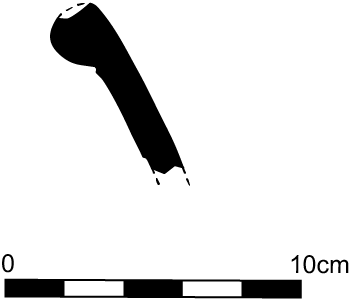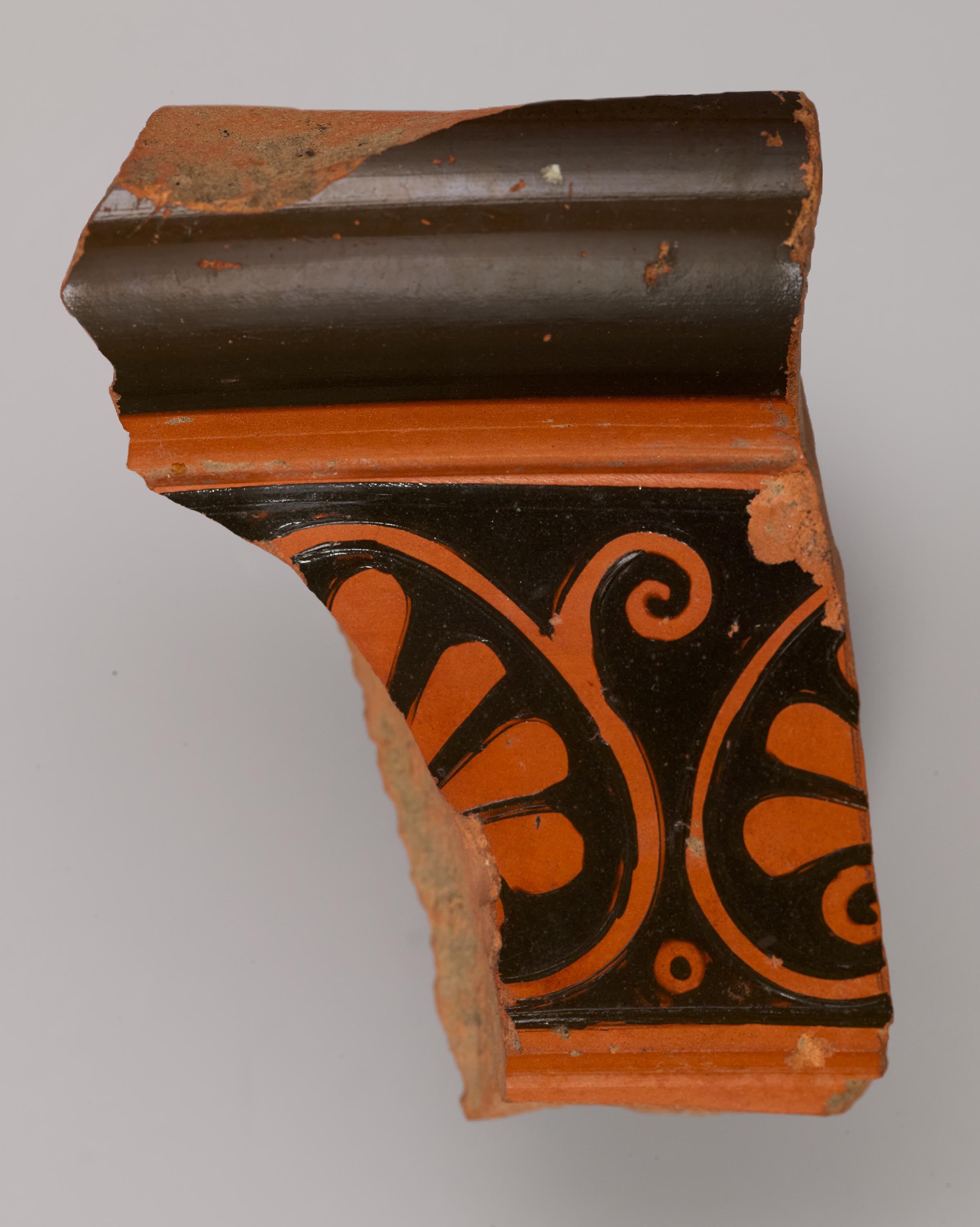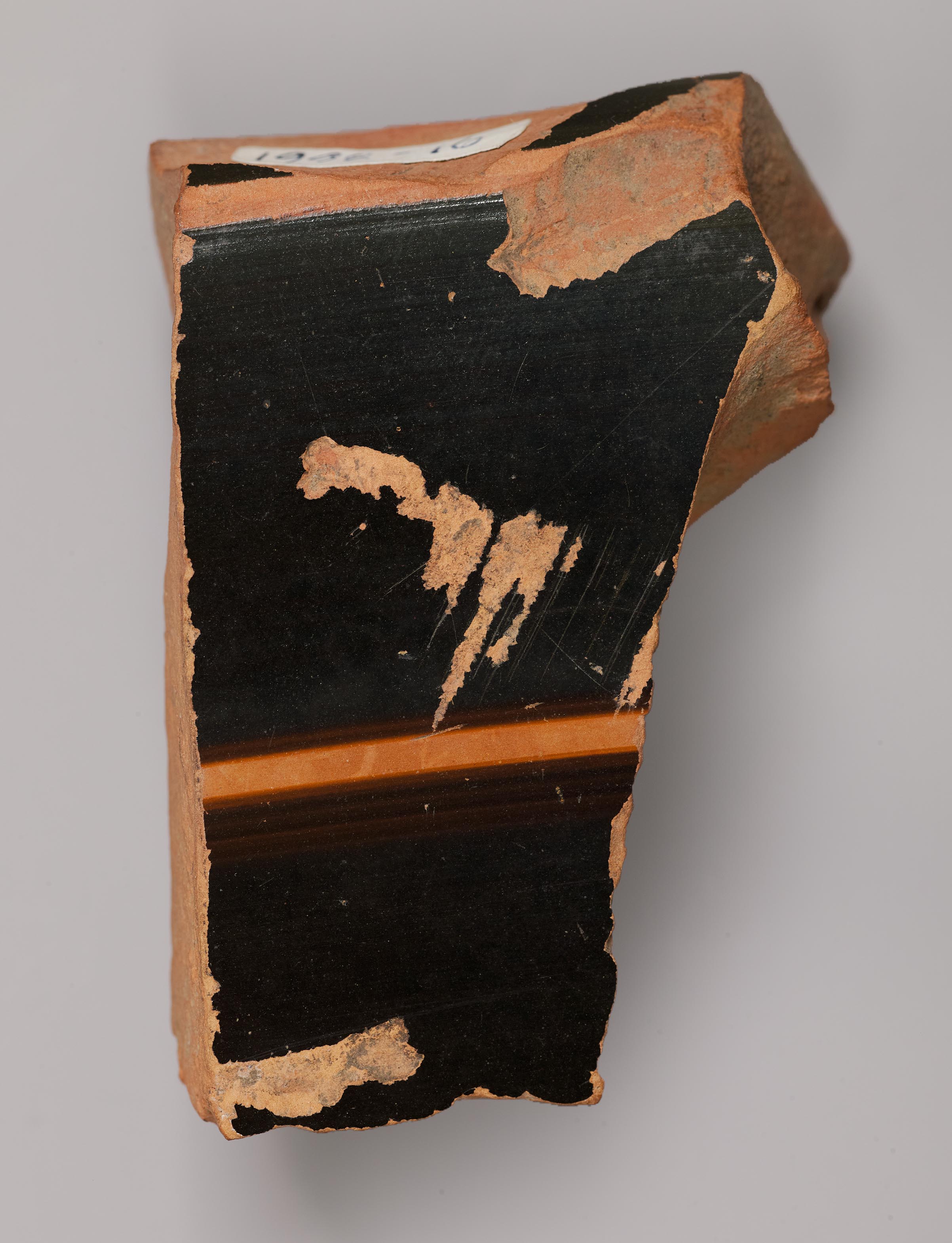Provenance
1998, sale, Edoardo Almagià (New York, NY) to Princeton University.
Shape and Ornament
Single fragment from flat, offset rim; torus lip. Two upright palmettes preserved on rim, enclosed within tendrils. On palmette at left, coiling tendril emerging from the shoulder. Small circle in the lower gap between palmettes. Reserved groove between lip and rim, and another at the base of the rim’s beveled ledge. No part of the wall below is preserved. Interior black, with two reserved stripes, one just below the rim and another 3.6 cm farther down.

Attribution and Date
Attributed to the Kleophrades Painter [W. L. Austin]. Circa 500–490 BCE.
Dimensions and Condition
6.0 × 4.4 cm; thickness: at torus lip 2.0 cm; at rim 1.0 cm. Broken on all sides, including the top of the lip. Black gloss slightly mottled on the lip, scraped in places on the interior. Gloss has a slightly greenish cast.
Technical Features
Relief contours for the palmettes except for the end of the shoulder tendril. The circle is not contoured.
Bibliography
Abbreviation: Princeton RecordRecord of the Princeton University Art Museum. (1942– ). 58 (1999): 114 [not illus.].
Comparanda
Enclosed, upright palmettes of this type, carefully contoured with relief lines and with coiling tendrils on the shoulder of every second unit, most often appear on calyx-kraters by Euphronios and the Kleophrades Painter; indeed, they are evidence, along with a preference for the shape itself, of the older artist’s influence on the younger. Euphronios also employed the motif on his only volute-krater: Arezzo 1465 (Abbreviation: ARV2J. D. Beazley. Attic Red-Figure Vase-Painters. 2nd ed. Oxford, 1963 15.6, 1619; Abbreviation: BAPDBeazley Archive Pottery Database. http://www.beazley.ox.ac.uk 200068). Differing markedly from those by the Kleophrades Painter, Euphronios’s palmettes have black cores and the tendrils on the shoulders always extend downward—“underhand”—before curling back. Cf. two calyx-kraters attributed to Euphronios: Munich NI 8935 (Abbreviation: ARV2J. D. Beazley. Attic Red-Figure Vase-Painters. 2nd ed. Oxford, 1963 1619.3 bis, 1705, 1699; Abbreviation: BAPDBeazley Archive Pottery Database. http://www.beazley.ox.ac.uk 275007); and Paris, Louvre G 110 (Abbreviation: ARV2J. D. Beazley. Attic Red-Figure Vase-Painters. 2nd ed. Oxford, 1963 14.3; Abbreviation: BAPDBeazley Archive Pottery Database. http://www.beazley.ox.ac.uk 200065). On Princeton’s fragment, in contrast, the tendrils on the shoulder first spring upward, the manner always adopted by the Kleophrades Painter. Like Euphronios, the Kleophrades Painter normally gives his palmettes seven fronds, but these stem from a reserved core, and never have a central spine, as sometimes occurs on palmettes by Euphronios. In addition to calyx-kraters, the Kleophrades Painter also painted such palmettes on a kalpis-hydria: Munich SH 2427 (Abbreviation: ARV2J. D. Beazley. Attic Red-Figure Vase-Painters. 2nd ed. Oxford, 1963 189.72, 1632; Abbreviation: BAPDBeazley Archive Pottery Database. http://www.beazley.ox.ac.uk 201720). Sometimes the lower spaces between the palmettes are vacant, as on the hydria in Munich (supra), and on the kraters Tarquinia RC 4196 (Abbreviation: ARV2J. D. Beazley. Attic Red-Figure Vase-Painters. 2nd ed. Oxford, 1963 185.35, 1632; Abbreviation: BAPDBeazley Archive Pottery Database. http://www.beazley.ox.ac.uk 201687), Athens, Agora P 6103 (Abbreviation: ARV2J. D. Beazley. Attic Red-Figure Vase-Painters. 2nd ed. Oxford, 1963 185.39; Abbreviation: BAPDBeazley Archive Pottery Database. http://www.beazley.ox.ac.uk 201691), and Athens, Kerameikos 1977a–g (Abbreviation: ARV2J. D. Beazley. Attic Red-Figure Vase-Painters. 2nd ed. Oxford, 1963 186.45; Abbreviation: BAPDBeazley Archive Pottery Database. http://www.beazley.ox.ac.uk 201697). On the krater Paris, Louvre G 48 (Abbreviation: ARV2J. D. Beazley. Attic Red-Figure Vase-Painters. 2nd ed. Oxford, 1963 185.33, 1632; Abbreviation: BAPDBeazley Archive Pottery Database. http://www.beazley.ox.ac.uk 201685), the lower spaces are occupied by elliptical buds, a motif favored by Euphronios; their appearance on rim fragments New York 2011.604.2.761 and Tarquinia, Gravisca 2973 (K. Huber, Gravisca: Le ceramiche attiche a figure rosse [Bari, 1999], 131, no. 69; Abbreviation: BAPDBeazley Archive Pottery Database. http://www.beazley.ox.ac.uk 25648), in combination with palmettes in the Kleophrades Painter’s distinctive manner, suggest that they, too, may be from his hand. The circles on the Princeton fragment occur also on a calyx-krater by the Kleophrades Painter (New York 08.258.58: Abbreviation: ARV2J. D. Beazley. Attic Red-Figure Vase-Painters. 2nd ed. Oxford, 1963 185.36; Abbreviation: BAPDBeazley Archive Pottery Database. http://www.beazley.ox.ac.uk 201688), making it the closest parallel overall. They turn up as well on a fragment from another calyx-krater, with parts of a satyr and a maenad, not far in style from the Kleophrades Painter: Malibu 85.AE.411 (an image appears under Abbreviation: BAPDBeazley Archive Pottery Database. http://www.beazley.ox.ac.uk 11658, in association with unrelated fragments by the Berlin Painter; see Abbreviation: Padgett, Berlin PainterJ. M. Padgett, with contributions by N. T. Arrington et al. The Berlin Painter and His World: Athenian Vase-Painting in the Early Fifth Century B.C. Princeton, 2017, 381, B116 bis). For the Kleophrades Painter in general, see Princeton 2002-164.1–2 (Entry 20).

